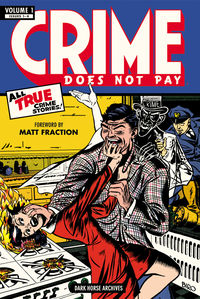Crime Does Not Pay Vol. 1 Intro by Matt Fraction

LOOK AT WHAT ALL THESE BLOODY LITTLE DIMES CAN GET YOU
BY MATT FRACTION
“She was giving me a bad time,” Bob Wood told the New York cops. He’d just murdered a divorced woman by beating her to death with an electric iron in a Gramercy Park hotel—the bloody punctuation mark at the end of a tawdry eleven-day affair.
He went to jail in 1958. He got out in 1961.
Not bad.
After that, Bob got a gig as a short-order cook somewhere in New Jersey. Some prison buddies came by one night looking for Bob, or looking for money Bob owed them, depending on the storyteller.
They found Bob’s body on the New Jersey Turnpike.
•
That sad, sexed-up, and salacious story of the end of Bob Wood’s life could have lived right at home within the ugly pulpy pages of publisher Lev Gleason’s legendary Crime Does Not Pay. This comic—the canary in the comic-book coal mine of good taste—lived in its sloppy, slipped-plate, four-color glory alongside its kissing cousins in depravity over at EC and, one presumes, in the penthouse floor of a metaphorical genre flophouse above many subpar others, moving between 200,000 and 800,000 copies over the years. At her ebb, Crime Does Not Pay moved about twice what the best-selling comic book moved last month.
Comic books, the perfect medium for lurid crime stories, grew up in crime’s shadow down the road from smut in the company of sleazy yellow New York tabloid newspapers. You can tell the familial relation at a glance. Hell, without newspapers wanting to advertise their color printing capabilities, comics wouldn’t exist.
In the molten and inky heart of the Venn-diagram overlap of organized booze smuggling, Canadian paper mills, the nascent print media, and a country needing very badly to be distracted, came comic books. Rich roots, those—as if the medium was made for this particular message. Comic Books: like the tabloids, but without all those pesky goddamn words to get in the way.
A cartoonist friend of mine in comics says, “No industry grows too far away from its roots, and comics’ roots were gangsters and pornography.”
My friend’s a damn genius, but I can’t tell if he’s holding his nose when he says that or not. See, to me, comics are low culture. I like low culture. Sooner or later, though, low culture gets people in trouble.
Crime and its nasty-ass brethren went and got noticed and blew the whole damn gig for everybody, and American comics, as an art form, have never really recovered.
Eight hundred thousand copies means lots of little minds warped. Lots of dimes moved across a lot of counters. Dimes turn into dollars, and dollars turn businesses into empires. Empires attract attention.
To cut to the punch line, a lionized shrink blamed comics for every single act of juvenile delinquency since Cain (He was under eighteen, right? I mean, he didn’t do any time, did he?), and the feds, eager to destroy any tendril of the mob they could, chipped away at comics—aiming to shut down paper concerns north of the border under the guise of that most cheap of glories of the public good—saving the children. And thus they held hearings and comics buckled like cheap belts from Sears, Roebuck and Co., self-censoring in 1954 and for decades swearing up and down, forever and ever, that Comics existed for children and only for children and thus would remain childish in their ways and polite and sweet and good in their ways and boring in their ways always and ever since Comics, in the minds of your fellow Americans, remained precisely THAT. Not low culture but slow culture. Dimwitted and simple. Lukewarm picture pamphlets for the subliterate set.
(The Comics Code Authority stopped functioning, even as a paper stamp, in 2010.)
(For my money, the best accounting of this remains Gerard Jones’s stellar Men of Tomorrow: Geeks, Gangsters, and the Birth of the Comic Book, and I trust you’ll seek it out rather than trust me to accurately encapsulate the whole sordid affair in this introduction. David Hajdu’s The Ten-Cent Plague, too. Buy those. Read those.)
By the time Crime Does Not Pay and the rest of the industry got shut down, one in eight comics published was a crime comic. Horror had to be close to that, and those were just as bad in terms of content, just as horrifying, just as prurient.
Just as low.
Now history and the wonderful heroes at Dark Horse Comics allow us to judge for ourselves as enlightened, educated, and practical adults.
Not on par with, say, the torture-porn glamour-grind films that pass for horror these days or even the soft-core fuel that modern comics spankerchiefs have to offer in terms of the extremity of content, these books from comics’ halcyon golden days nonetheless contained, to quote imminent scholar Dr. Winston Zeddemore, “shit that’ll turn you white.”
Just the covers. Oh, MAN, the covers.
CRIME, the covers shouted in colossal white letters.
CRIME.
“Does not pay,” they whispered, in a far smaller font, politely retreating from view.
Just like those AIDS pamphlets that ruined my tween years, dropped on middle schools across America like Hiroshima warnings promising that—
SEX!!
—will totally almost certainly kill you if you ever have it never have sex ever just go home and pray the boners away for your health—
Which duly smothered a generation of boners before they could even BEGIN to start causing trouble.
Thirty-five years earlier, the covers of Crime Does Not Pay, all adorned by a caption box promising “All True Crime Stories!,” delivered some of the most ghastly and lurid illustrations of criminal activity imaginable to prove their bloody point.
This art lived a good country mile past the last signpost for good taste.
The covers in this collection alone promise the old knife-through-a-hand gag, some mug shoving a woman’s head ONTO THE LIT BURNER OF A STOVE, causing her hair to ignite, a three-man murder squad Tommy gunning a man to death in a phone booth, and a full-bore prison riot with at least three dead cops.
Right there!
Right there on the cover!
DEAD. COPS.
Where ANYONE COULD SEE!
(My favorite Crime Does Not Pay cover, not in this collection, but worth bringing up all the same, doesn’t illustrate a single gunshot, stabbing, or death, but rather, a car full of sexual predators cruising a girls’ school where a prepubescent girl innocently twirls her skirt in the direction of a goon offering her an ice-cream cone. Inside the car we see one of the men fumbling with a length of rope. Just another day, apparently, in the empire of Lev Gleason.)
Before this collection, save for about thirty-something scanned pages, I never had the opportunity to read anything beyond the covers. That said, this collection thrills me to no end, if for no other reason than I finally confirmed, in reading the thing, that Crime Does Not Pay comics stand as sensational, as sick, and as violently warped and titillating on the insides as they are on the outsides.
These comics, I can declare, do indeed represent the lowest of low culture.
I am thrilled—nonironically and to the core of my being—that Crime Does Not Pay now claws its way from its shallow grave to hopefully warp, scar, spook, titillate, and delight the generations of us robbed of its presence until now.
•
By the way—Bob Wood—our guy mentioned up at the top who brained his lady friend with an iron? He edited Crime Does Not Pay for Lev Gleason for almost thirteen years. Apparently he never read the damn thing.
DON’T MAKE THE SAME MISTAKE!
READ CRIME DOES NOT PAY!
—Matt Fraction
Portland, Oregon



